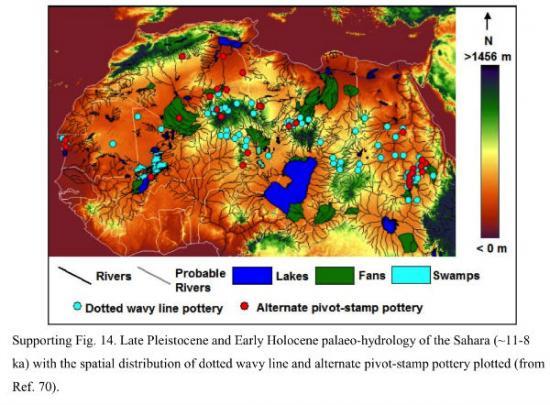Fish Swam the Sahara, Bolstering Out of Africa Theory
Charles Q. Choi
Source : http://www.livescience.com/animals/fish-possibly-swam-across-sahara-101228.html

A map of what the Sahara was like 8,000 to 11,000 years ago, revealing rivers, lakes, swamps and fan-shaped deposits where rivers emptied out. The dots indicate where various kinds of pottery were found. Credit: Nick Drake.
Fish may have once swum across the Sahara, a finding that could shed light on how humanity made its way out of Africa, researchers said.
The cradle of humanity lies south of the Sahara, which begs the question as to how our species made its way past it. The Sahara is the largest hot desert in the world, and would seem a major barrier for any humans striving to migrate off the continent.
Scientists have often focused on the Nile Valley as the corridor by which humans left Africa. However, considerable research efforts have failed to uncover evidence for its consistent use by people leaving the continent, and precisely how watery it has been over time is controversial.
Now it turns out the Sahara might not have been quite as impassable as once thought — not only for humanity, but for fish as well.
"Fish appeared to have swam across the Sahara during its last wet phase sometime between 10,000 and 6,000 years ago," researcher Nick Drake, a geographer at King's College London, told LiveScience. "The Sahara is not a barrier to the migrations of animals and people. Thus it is possible — likely? —that early modern humans did so, and this could explain how we got out of Africa."
Using satellite imagery and digital maps of the landscape, the researchers found the Sahara was once covered by a dense network of rivers, lakes and inland deltas. This large waterway channeled water and animals into and across the Sahara during wet, "green" times.
In their analysis, Drake and his colleagues found evidence that many creatures, including aquatic ones, dispersed across the Sahara recently. For example, 25 North African animal species have populations both north and south of the Sahara with small refuges within the desert, including catfish (Clarias gariepinus), tilapia (Tilapia zillii), jewel cichlid fish (Hemichromis letourneuxi) and freshwater snails such as the red-rimmed melania (Melanoides tuberculata). Indeed, more animals may have once crossed over the Sahara than over the Nile corridor, the researchers said — only nine animal species that occupy the Nile corridor today are also found both north and south of the Sahara.
If fish could have crossed the Sahara, it is hard to imagine that humans didn't. Analysis of African languages and artifacts suggest that ancient waterways recently affected how humans occupied the Sahara. For instance, speakers of Nilo-Saharan languages once lived across central and southern Sahara, and may have once hunted aquatic creatures with barbed bone points and fish hooks. In addition, ancient lake sediments suggest the Sahara was green roughly 125,000 years ago, back when anatomically modern humans might have begun migrating out of Africa.
Future work could focus on when species got across the Sahara — genetic analysis of fish could help pinpoint such times in fish, Drake said. However, further research into the past of the Sahara could prove difficult and even dangerous, he noted. Some of the Saharan countries the researchers would like to visit in order to analyze the genetics of fish populations or date the ages of ancient shorelines "are deemed to be too dangerous to visit due to terrorist activity or civil war," Drake said.
The scientists detailed their findings online Dec. 27 in the journal Proceedings of the National Academy of Sciences.
Ancient watercourses and biogeography of the Sahara explain the peopling of the desert
- Nick A. Drakea,1,
- Roger M. Blenchb,
- Simon J. Armitagec,
- Charlie S. Bristowd, and
- Kevin H. Whitee
+ Author Affiliations
1. aDepartment of Geography, King’s College London, Strand, London WC2R 2LS, United Kingdom; 2. bKay Williamson Educational Foundation, 8 Guest Road, Cambridge CB1 2AL, United Kingdom; 3. cDepartment of Geography, Royal Holloway, University of London, Egham, Surrey TW20 0EX, United Kingdom; 4. dSchool of Earth Sciences, Birkbeck College, University of London, Malet Street, London WC1E 7HX, United Kingdom; and 5. eDepartment of Geography, University of Reading, Whiteknights, Reading RG6 6AB, United Kingdom
- Edited by Ofer Bar-Yosef, Harvard University, Cambridge, MA, and approved November 22, 2010 (received for review August 23, 2010)
Source : http://www.pnas.org/content/early/2010/12/23/1012231108.abstract?sid=1fb8c392-c8db-40fc-acd8-3a2533a6d664
Abstract
Evidence increasingly suggests that sub-Saharan Africa is at the center of human evolution and understanding routes of dispersal “out of Africa” is thus becoming increasingly important. The Sahara Desert is considered by many to be an obstacle to these dispersals and a Nile corridor route has been proposed to cross it. Here we provide evidence that the Sahara was not an effective barrier and indicate how both animals and humans populated it during past humid phases. Analysis of the zoogeography of the Sahara shows that more animals crossed via this route than used the Nile corridor. Furthermore, many of these species are aquatic. This dispersal was possible because during the Holocene humid period the region contained a series of linked lakes, rivers, and inland deltas comprising a large interlinked waterway, channeling water and animals into and across the Sahara, thus facilitating these dispersals. This system was last active in the early Holocene when many species appear to have occupied the entire Sahara. However, species that require deep water did not reach northern regions because of weak hydrological connections. Human dispersals were influenced by this distribution; Nilo-Saharan speakers hunting aquatic fauna with barbed bone points occupied the southern Sahara, while people hunting Savannah fauna with the bow and arrow spread southward. The dating of lacustrine sediments show that the “green Sahara” also existed during the last interglacial (∼125 ka) and provided green corridors that could have formed dispersal routes at a likely time for the migration of modern humans out of Africa.